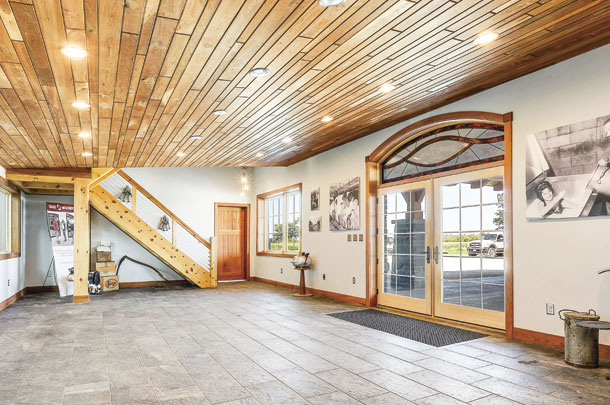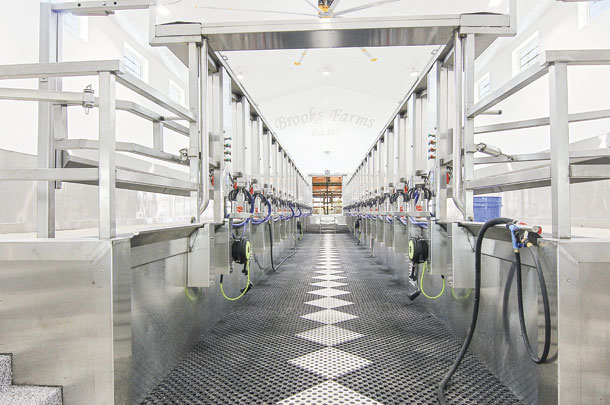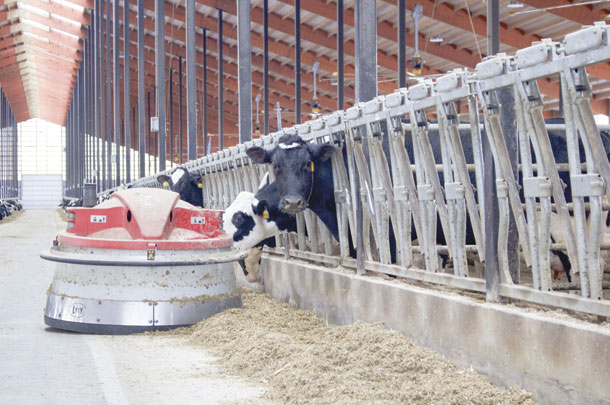Farming has been the center of the Brooks family heritage for more than 160 years and, with a new facility and the next generation at the helm, the tradition is set to continue.
Brooks Farms in Waupaca, Wisconsin, is on pace to fill their recently constructed freestall barn to its 700-cow capacity. In the former facility, they maxed out with 230 cows in an outdated double-six parlor and 1970s barn. Zoey Brooks and her father, Ron, recognized investments needed to be made to support her return to the operation.
“The next generation couldn’t take the business forward in the old barn,” Zoey Brooks says. But with a new barn and milking parlor, she is now confident in the opportunity that lies ahead. “We built this for the future,” she adds.

Just shy of one year in the new facility, Brooks sees the years of planning that went into the project paying off. She’s pleased with the environment for both animals and people. “Cow comfort was the big goal of getting in the new barn,” she says, “but we wanted a better environment for employees too.”
See more of the new facility in this slideshow.
Building a barn for comfort
Ventilation was top on the list of Brooks’ cow comfort must-haves. They looked at the options of cross, tunnel and natural ventilation but decided on an innovative design to capitalize on the prevailing southwest winds and save on energy costs.
“We wanted to work with the environment instead of fighting it,” Brooks says.
The resulting barn features 16-foot sidewalls to accommodate several high-speed low-velocity fans hovering over the pens. A rooftop weather station senses wind direction, velocity, rain, snow and temperature, and automatically adjusts curtains and fans accordingly to create the “perfect environment” for cows. “We had virtually no heat stress last summer,” she notes. “And the air quality is so much better.”
Even when the weather turns cold, Brooks can’t complain about the ventilation choice. “The barn never fogged last winter,” she says. “We can keep the fans on low to keep the air moving and let a little fresh air in. There’s never any ammonia smell.”
Comfortable stalls were also a high priority, which is why they wanted to continue using deep sand bedding. Upon first moving cows into the barn, brisket rail placement proved to be a challenge, resulting in injuries and decreased lying times. Removing the rails increased lying time by three hours a day but resulted in dirtier stalls. They have recently replaced the rails and adjusted placement to better accommodate their large-framed cows.
Cow brushes were also a must in this barn, with one in every pen, and rubber provides relief in the feed alleys, parlor and holding area. “Any time the cows are standing, they get to stand on rubber instead of concrete,” she adds.
The ‘cleanest, quietest’ milking parlor
The double-16 herringbone parlor is the epitome of comfort.

“We wanted to challenge the builder to make it the cleanest, quietest parlor he’s ever installed,” Brooks adds.
For that reason, they chose a basement to house pulsators, milk meters and colostrum collection. This keeps the pit tidy and protects the equipment from water exposure while achieving their number one goal of a calm and quiet milking atmosphere. “All you hear is milk flowing in the parlor,” she says.
Even through the stress of moving, somatic cell count never exceeded 100,000. With some fine-tuning of the equipment and milking routine, that number is back where Brooks like to see it. “We run around 50,000,” she says. “We’ve always prided ourselves on milk quality.”
Pin-pointing with precision
Precision parlor technology is one of Brooks’ favorite parts of the facility. The AfiMilk system has opened up a plethora of actionable milking data that allows her to take quality management to the next level. “I love that we can track per shift, per cow, how that cow is milking,” she says. “We are able to pull up individual milking reports when we have a new person in the parlor or if we are having issues with milk flow or timing.”
Brooks uses this real-time information to pinpoint problems and monitor solutions instantly, without having to wait for bulk tank test results. An issue with milk letdown was resolved by tweaking the stimulation setting to more effectively trigger oxytocin release. She notes, “We improved our first 15-second milk fourfold.”
The data collection software works in conjunction with an automated sorting gate that diverts flagged cows to a treatment area upon exiting the parlor. This eliminates the need to lock up entire groups of cows, thus saving time for workers and improving comfort for cows.
“It’s been great for preg checks, herd checks and hoof trimming,” she says. “It really streamlines the process and takes a lot of work out of sorting.”
The gate can be programmed to sort off cows that need treatments or shots, falling in line with Brooks’ belief that type of work should not be done in the milking parlor. “We want cows to know they come in there only to be milked,” she says.
While the parlor was designed to provide ultimate comfort for cows, Brooks admits this has led to an unexpected challenge. “One thing we didn’t anticipate was cow flow through the parlor,” she says. “Cows come in, but they don’t want to leave.”
They’ve tried different approaches to remedy the problem with little improvement, including grinding down the cobblestone return alleys and checking for stray voltage. They are currently working with a stockmanship expert to break cows of the habit of hanging around too long in the parlor.
Based on this experience, Brooks recommends including a consultant on cow movement and flow from the get-go. “Bring in an animal behaviorist on the planning process instead of bringing them in to fix a problem later,” she suggests.
Incorporating automated technology
Out in the barn, it’s just as calm and quiet as in the parlor. The Brookses chose automated technology to replace work formerly done by a skid steer, such as pushing feed and scraping pens. An automatic feed pusher keeps the ration within cows’ reach, pushing in feed multiple times a day.

Likewise, alley scrapers run continually to keep pens clean. This decision came down to labor. “We asked the foreman who does a lot of the maintenance work, ‘Do you want to fix gates other people are breaking, or do you want to do routine maintenance on alley scrapers?’” she says. “It also gives a broader range of people we can hire because they don’t need to have skid steer experience.”
‘People who love cows’
Though Brooks replaced some of the dairy’s tasks with technology, she finds good cow people can’t be substituted by a machine. That’s why they made the dairy appealing to employees, with perks like a break room, locker room, shower and laundry access. In the parlor, milkers enjoy in-floor heat and satellite radio.
The focus on employee satisfaction has paid off with a team of seasoned staff and part-time help, many of whom have their own dairy farms or work on others in the neighborhood. She places high value on the skill set and intuition of these individuals.
“We’ve found our niche of people who love cows,” Brooks says. “Tractor people are a dime a dozen, but finding people who love cows and want to work with cows is rare.”
Brooks Farms is invested in the future, built on a solid foundation of dairying experience and now with a facility set for both cows and people to thrive for years to come. ![]()
PHOTO 1: The Brooks family’s new facility was built to be a “welcoming place,” according to Zoey Brooks
PHOTO 2: Inside the main entrance, enlarged photographs tell of the family’s dairy heritage, and antique dairy equipment serves as décor.
PHOTO 3: The double-16 parlor is designed to be a “one-man” parlor, with only two people required per shift. The milker does not leave the pit, while the other person brings up cows, cleans stalls and waterers and checks the maternity pen. Photos provided by Forest Construction Inc.
PHOTO 4: The automatic feed pusher is programmed with its own playlist that prompts cows to come to the bunk. Music replaces the sound of the skid steer to signal pushups. Photo by Peggy Coffeen.

-
Peggy Coffeen
- Editor
- Progressive Dairyman
- Email Peggy Coffeen






